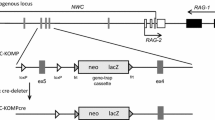Abstract
Members of the Pax gene family have recently been shown to play important roles in mouse embryogenesis. Of eight so far characterized Pax genes, three have been associated with mouse developmental mutants. Here we report the cloning of a new Pax gene, Pax-9. Most of the DNA sequence encoding the highly conserved paired domain has been determined and compared with previously known paired domains. This comparison classifies Pax-9 as a member of the same subgroup as Pax-1/undulated. By analysis of the segregation of a Pax-9 restriction fragment length polymorphism and a large number of simple sequence length polymorphisms in an interspecific C57BL/6 x Mus musculus mollosinus backcross, Pax-9 was mapped close to the D12Nds1 locus on the proximal part of Chromosome (Chr) 12.
Similar content being viewed by others
References
Baldwin, C.T., Hoth, C.F., Amos, J.A., da-Silva, E.O., Milunsky, A. (1992). An exonic mutation in the HuP2 Paired domain gene causes Waardenburg's syndrome. Nature 355, 637–638.
Balling, R., Deutsch, U., Gruss, P. (1988) Undulated, a mutation affecting the development of the mouse skeleton, has a point mutation in the paired box of Pax 1. Cell 55, 531–535.
Bopp, D., Burri, M., Baumgartner, S., Frigerio, G., Noll, M. (1986). Conservation of a large protein domain in the segmentation gene paired and in functionally related genes of Drosophila. Cell 47, 1033–1040.
Bopp, D., Jamet, E., Baumgartner, S., Burri, M., Noll, M. (1989). Isolation of two tissue-specific Drosophila paired box genes, pox meso and pox neuro. EMBO J. 8, 3447–3457.
Burri, M., Tromvoukis, Y., Bopp, D., Frigerio, G., Noll, M. (1989). Conservation of the paired domain in metazoans and its structure in three isolated human genes. EMBO J. 8, 1183–1190.
Chalepakis, G., Fritsch, R., Fickenscher, H., Deutsch, U., Goulding, M., Gruss, P. (1991). The molecular basis of the undulated/Pax-1 mutation. Cell 66, 873–884.
Church, G.M., Gilbert, W. (1984). Genomic sequencing. Proc. Natl. Acad. Sci. USA 81, 1991–1995.
Deutsch, U., Dressler, G.R., Gruss, P. (1988). Pax1, a member of a paired box homologous murine gene family, is expressed in segmented structures during development. Cell 53, 617–625.
Devereux, J., Haeberli, P., Smithies, O. (1984). A comprehensive set of sequence analysis programs for the VAX. Nucleic Acids Res. 121, 387–395.
Dietrich, W., Katz, H., Lincoln, S.S., Shin, H.-S., Friedman, J., Dracopoli, N.S., Lander, E.S. (1992). A genetic map for the mouse suitable for typing intraspecific crosses. Genomics 131, 423–447.
Epstein, D.J., Vekemans, M., Gros, P. (1991). Splotch (Sp 2h), a mutation affecting development of the mouse neural tube, shows a deletion within the paired homeodomain of Pax-3. Cell 67, 767–774.
Feinberg, A.P., Vogelstein, B. (1983). A technique for radiolabeling DNA restriction endonuclease fragments to high specific activity. Anal. Biochem. 132, 6–13.
Gruss, P., Walther, C. (1992). Pax in development. Cell 69, 719–722.
Hill, R.E., Favor, J., Hogan, B.L.M., Ton, C.C.T., Saunders, G.F., Hanson, I.M., Prosser, J., Jordan, T., Hastie, N.D., van Heyningen, V. (1991). Mouse Small eye results from mutations in a paired-like homeobox-containing gene. Nature 354, 522–525.
Jarcho, S., Levin, P.M. (1938). Hereditary malformations of the vertebral bodies. Bull. Johns Hopkins Hosp. 62, 216–226.
Jordan, T., Hanson, I.M., Zalateyev, D., Hodgson, S., Prosser, J., Seawright, A., Hastie, N.D., van Heyningen, V. (1992). The human Pax-6 gene is mutated in two patients with aniridia. Nature Genet 1, 328–332.
Kessel, M., Gruss, P. (1990). Murine developmental control genes. Science 249:374–379.
Sambrook, J., Fritsch, E.F., Maniatis, T. (1989). Molecular Cloning: A Laboratory Manual, 2nd ed. (Cold Spring Harbor, N.Y.: Cold Spring Harbor Laboratory Press).
Sanger, F., Nicklen, S., Coulsen, A.R. (1977). DNA sequencing with chain-termination inhibitors. Proc. Natl. Acad. Sci. USA 74, 5463–5467.
Tassabehji, M., Read, A.P., Newton, V.E., Harris, R., Balling, R., Gruss, P., Strachan, T. (1992). Waardenburg syndrome patients have mutations in HuP2, the human homologue of mouse Pax-3 and Splotch. Nature 355, 635–636.
Ton, C.C.T., Hirvonen, H., Miwa, H., Weil, M.W., Monaghan, P., Jordan, T., van Heyningen, V., Hastie, N.D., Meijers-Heijboer, H., Drechsler, M., Royer-Pokora, B., Collins, F., Swaroop, A., Strong, L.C., Saunders, G.F. (1991). Positional cloning and characterization of a paired box- and homeo box-containing gene from the aniridia region. Cell 67, 1059–1074.
Treisman, J., Harris, E., Desplan, C. (1991). The paired box encodes a second DNA-binding domain in the Paired homeo domain protein. Genes Dev. 5, 594–604.
Walther, C., Guénet, J.-L., Simon, D., Deutsch, U., Jostes, B., Goulding, M., Plachov, D., Balling, R., Gruss, P. (1991). Pax: a murine multigene family of paired box containing genes. Genomics 11, 424–434.
Author information
Authors and Affiliations
Rights and permissions
About this article
Cite this article
Wallin, J., Mizutani, Y., Imai, K. et al. A new Pax gene, Pax-9, maps to mouse Chromosome 12. Mammalian Genome 4, 354–358 (1993). https://doi.org/10.1007/BF00360584
Received:
Accepted:
Issue Date:
DOI: https://doi.org/10.1007/BF00360584



